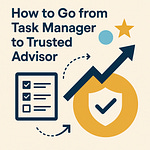A number of years ago I was working with one of my clients who was a very talented marketing operations manager when I was a customer success manager at Eloqua (a marketing automation platform). Their goal was to deliver more targeted content to their prospects but the data that they stored in Eloqua was all over the place as data tends to be. They had collected contact information in a very unwieldy manner over the years. As an example, for the country field, United States was spelled in 20 different ways: USA, US, United States, America, 'merica. You get the point.
“I have a great solution for you” I quickly exclaimed. “It’s called the data washing machine”. No joke. It really was called that and probably still is. I continued: “It will help you clean up your data through a series of rules in our workflow engine”. The challenge was that this workflow engine in Eloqua called “Program Builder” was a beast and not the easiest product to use. I could see the hesitancy in my client’s face as we spoke as I knew they had a lot on their plate already. It was obvious that I was losing them. “It’s ok,” they said. “We’ll just export the data and fix it ourselves”. I knew that this wouldn’t be the right move and would add countless hours to their campaign creation process. How could I turn this around?
I decided to switch gears and started to talk about another one of our clients that were similar to them and had the same problem. They just happened to know the marketer over there as well. I remember telling them “Yeah, Dox also had that issue. They had a number of challenges targeting the right prospect by title so they used their washing machine to bucket people into their designated personas. The great thing is that after they implemented their own contact washing machine their email open rate went up by 20%, they generated 30% more qualified leads and they doubled the number of monthly campaigns they executed. Do you want to have a chat with Mary over at Dox? I can set that up. It’s up to you”. I saw a glimmer of light in my client’s eyes. “Well, there’s no harm in having a chat with Mary. It would be great if you could reintroduce us” they said. I had hit paydirt and prevented them from digging a deeper hole for themselves. All with the power of a story.
Tell it, don’t sell it
I was off to the races and built out a plan to get them using my proposed solution. The strength of stories is extremely underrated when it comes to customer success. While you may have a great product or service, your customers may not be ready for what you have to offer even though it will solve their problem. It’s foolish to think that someone will do what you say just because you said it. It’s best to consider a story that can help bridge the gap between your product or service and their need. In this case, a customer story was the right tool. My goal was to have them visualize what the end result may look like which was why I shared the success metrics. I focused on telling the story rather than selling the benefits of the contact washing machine. I then proposed to have one of our other customers tell it to them directly which is even more powerful.
I also used a bonus technique to counteract the psychological effect called “reactance” which happens when people feel you may be too pushy. Think of that annoying associate that comes up to you in your favorite clothing store and asks “can I help you?”. 99% of the time you want to scream “No, go away” but of course you don’t say that out loud. By saying “it’s up to you” I let the customer decide what they want to do next and I made it an easy first step. Giving your customers freedom and options can help people take the first step when they may be hesitant to.
Gather those stories
Your challenge: What stories do you or your team have that should be used to help change the behavior of your customers? Customer success managers should have a bank of stories that they have close at hand and can easily leverage. Most likely, they already exist but they haven’t been brought together. You can start to gather them - even if they are in a rough draft to start. You can then refine them and work with your team on how best to deliver them. That is coming up in a future post so stay tuned….
Look for those stories - they are there:
PS: this post was an example of a story












